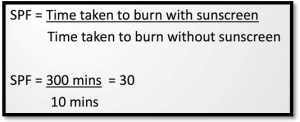
Sunscreen Advice
Sunscreen is an important part of any sunprotection regime used in combination with sunprotection clothing (including sun shirts (rashies), hats and sunglasses)
WHAT IS SPF AND WHY IS IT IMPORTANT (SUNPROTECTION FACTOR)?
 The SPF refers to the Sun Protection Factor of a cream. It is a ratio of the time taken to burn with sunscreen applied compared to the time taken to burn without sunscreen. UV exposure is directly related to skin cancer risk and higher SPF creams filter (stop) more UV from reaching your skin than to lower SPF options.
The SPF refers to the Sun Protection Factor of a cream. It is a ratio of the time taken to burn with sunscreen applied compared to the time taken to burn without sunscreen. UV exposure is directly related to skin cancer risk and higher SPF creams filter (stop) more UV from reaching your skin than to lower SPF options.
COMPARING SPF (30+spf versus 50+spf)
- SPF30 sunscreen filters 96.67% of UV radiation while a SPF 50+ filters 98.33% of UV radiation.
- The difference between 30+ and 50+ appears small however it is important to focus on the amount of UV that reaches your skin.
- 30+ spf allows 3.33% of UV to reach the skin
- 50+ spf allows 1.67% of UV to reach the skin
- The 50+spf halves the amount of UV that actually reaches your skin compared to 30+spf creams.
- Skin cancer is directly related to cumulative UV exposure over your lifetime. By using a 50+spf over a 30+spf you will potentially halve your exposure.
WHAT DOES BROAD SPECTRUM MEAN
- Broad-spectrum means that the sunscreen filters both UVA and UVB radiation.
SUNSCREEN APPLICATION
- Sunscreen does not provide full protection and is only part of being sunsmart.
- Sunprotection clothing (clothing, hat and sunglassed) and sun avoidance are essential.
- Apply sunscreen 20minutes prior to sun exposure and again every 2 hours
Quantity
- 1 teaspoon (5mls) per area of application ie limbs, front plus back and head.
- 35mls = approximate full body application adult
- Some sunscreens contains ingredients that may trigger an allergic reaction or irritation. In this instance your Dermatologist can recommend alternative sunscreens.
SUNSCREEN AND CHILDREN
- We encourage parents to let Children who can apply the cream to themselves to do so.
- Again you tube video from sunsmart , can we insert this in our website
SUNSCREEN AND NANOPARTICLES
- Many sunscreens contain the physical blockers Zinc and Titanium Dioxide. These products are often in the form of nanoparticles.
- Nanoparticles are smaller than 100 nanometres and invisible to the human eye – a nanometre is 0.000001 millimetre.
- Nanotechnology has been used in sunscreens for many years
- Both the Cancer Council and TGA have endorsed nanoparticle technology in sunscreens as safe
- There is no credible evidence that sunscreens containing nanoparticles pose a health risk.
- Sunscreen has been scientifically proven to reduce the risk of melanoma and other skin cancers.
- It is estimated that with appropriate use of sunscreen the prevalence of all skin cancers could be reduced by 10–15%, and that daily use could reduce the risk of melanoma by 75% and squamous cell cancer by 40%.
- (Queensland Health. The health of Queenslanders 2016. Report of the Chief Health Officer Queensland Government. Brisbane 2016.
REACTIONS TO SUNSCREEN
- Some people will react to ingredients in sunscreens.
- This may present as a burning, itchy or even blistering rash in the areas of application and may be confused with sunscreen
- This reaction occurs more often in sunscreens containing chemical absorbers rather than the physical blocking sunscreens (containing zinc oxide and titanium dioxide)
- We recommend patch testing all new sunscreens on a small area of skin first to determine whether you will tolerate the cream.
Dermatologists can advise regarding lower irritant options and can arrange allergy patch testing for the components of sunscreen that may be triggering the reaction.
Download our FactSheet here.


